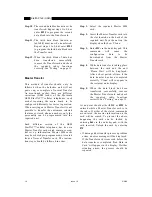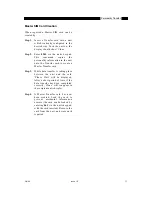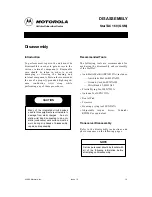
2/6/98
Issue 1.0
5
Theory of Operation
The data blocks are modulated onto the
carrier using Gaussian Minimum Shift
Keying (GMSK), a very efficient method of
phase modulation.
Figure 2: TDMA Transmission
Each time an information burst is trans-
mitted, it may be transmitted on a different
frequency. This process is known as
frequency hopping. Frequency hopping
reduces the effects of fading, and enhances
the security and confidentiality of the link. A
GSM radiotelephone is only required to
transmit for one burst in each frame, and not
continually, thus enabling the unit to be
more power efficient.
Each radiotelephone must be able to move
from one cell to another, with minimal
inconvenience to the user. The mobile itself
carries out signal strength measurements on
adjacent cells, and the quality of the traffic
channel is measured by both the mobile and
the base station. The handover criteria can
thus be much more accurately determined,
and the handover made before the channel
quality deteriorates to the point that the
subscriber notices.
When a radiotelephone is well within a cell,
the signal strength measured will be high.
As the radiotelephone moves towards the
edge of the cell, the signal strength and
quality measurement decreases.
Signal information provides an indication of
the subscriber’s distance from the base
station. As the radiotelephone moves from
cell to cell, its control is handed from one
base station to another in the new cell.
This change is handled by the radiotele-
phone and base stations, and is completely
transparent to the user.
Service Area
The area within which calls can be placed
and received is defined by the system opera-
tors. (Because this is a radio system, there is
no exact boundary that can be drawn on a
map.) If the telephone is outside a coverage
area, the
(no service) indicator will illumi-
nate and calls will be unable to be placed or
received. If this happens during a conversa-
tion, the call will be lost. There may also be
small areas within a particular service area
where communications may be lost.
The radiotelephone’s identity information
is held by its local GSM system in its Home
Location Register (HLR) and Visitor Loca-
tion Register (VLR). The VLR contains iden-
tity information on all local active
radiotelephones. Should you roam to
another area, system or country the radio-
telephones identity information is sent to
the VLR in the new system. The new system
will then check the radiotelephones details
with your home system for authenticity. If
everything is in order it will be possible to
initiate and receive calls whilst in the new
area.
0 1 2 3 4 5 6 7 0 1 2 3 4 5 6 7 0 1 2 3 4 5 6 7 0 1 2 3 4 5 6 7
Frame 0
Frame 3
Frame 2
Frame 1
User Data Sectioned Into Blocks
Information Bursts Sent In Allocated Time Slots
Summary of Contents for cd 160
Page 7: ...viii Issue 1 0 2 6 98 StarTAC 160 GSM ...
Page 9: ...2 Issue 1 0 2 6 98 StarTAC 160 GSM ...
Page 13: ...6 Issue 1 0 2 6 98 StarTAC 160 GSM ...
Page 17: ...10 Issue 1 0 2 6 98 StarTAC 160 GSM ...
Page 25: ...18 Issue 1 0 2 6 98 StarTAC 160 GSM ...
Page 65: ...58 Issue 1 0 2 6 98 StarTAC 160 GSM Figure 27 StarTAC Parts Illustration ...
Page 67: ...60 Issue 1 0 2 6 98 StarTAC 160 GSM ...
Page 75: ...68 2 6 98 ...













































